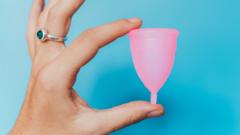Recent medical reports are ringing alarm bells over the usage of menstrual cups, highlighting potential risks when they are improperly fitted or misused. In one alarming case, a woman in her 30s developed temporary kidney complications that stemmed from inconsistent positioning of the menstrual cup, leading to pelvic pain and blood in her urine. Unbeknownst to her, the symptoms were directly linked to the cup pressing against her ureters, the tubes that transport urine to the bladder.
Medical experts stress that while such incidents are exceptionally rare, they are nonetheless serious, urging users to select the correct size, shape, and to ensure proper insertion of menstrual cups. According to the Danish doctors featured in the British Medical Journal, the onus is on both manufacturers and healthcare providers to provide clear guidance regarding the use of these products.
Menstrual cups, crafted from soft, flexible materials like silicone or rubber, serve as an eco-friendly alternative to traditional pads and tampons, with the ability to hold significant amounts of menstrual fluid. Many women appreciate their capacity to be emptied and reused multiple times throughout the day. However, they can pose challenges, especially for first-time users. A survey conducted among 530 young individuals revealed struggles with removal techniques, leading some to seek assistance.
As advised by pelvic health expert Dr. Kate Lough, users should avoid pulling on the stem of the cup when removing it. Instead, squeezing the base can help break the suction seal for easier removal. She reassures that menstrual cups, when used correctly, are very safe: "You shouldn't feel it once it's properly in place."
Dr. Lough encourages users to explore various cup models to find the best personal fit, as they differ in shape, size, and firmness. Moreover, women who have recently had a contraceptive coil fitted should be aware of minimal risks regarding dislodgment from suction and are advised to consult a healthcare professional if they suspect any issues.
In addition to menstrual cups, menstrual discs provide another option; however, they are positioned higher in the vaginal canal. As the dialogue surrounding menstrual products evolves, experts emphasize the necessity for continued education for users, thus ensuring safety and comfort.



















